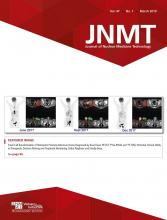RATIONALE
DaTscan (123I-ioflupane injection; GE Healthcare) is a molecular imaging agent that shows the location and concentration of dopamine transporters (DaTs) in the synapses of striatal dopaminergic neurons. DaT imaging assists in differentiating possible parkinsonian syndrome from other movement disorders such as essential tremor in adults.
CLINICAL INDICATIONS
Visualization of striatal DaT using brain SPECT to assist in the evaluation of adults with suspected parkinsonian syndromes.
Differentiation of essential tremor from tremor due to parkinsonian syndromes (idiopathic Parkinson disease, multiple-system atrophy, and progressive supranuclear palsy).
CONTRAINDICATIONS
Pregnancy.
Inability to cooperate or remain immobile for the entire scan.
Known hypersensitivity to the active substance or to any of its excipients (an iodine allergy is not a contraindication to receiving this tracer).
A recent radiopharmaceutical-dependent nuclear medicine study.
Breastfeeding (a relative contraindication; as a precaution, breast milk should be pumped and discarded for at least 1 d and up to 6 d after tracer administration).
PATIENT PREPARATION/EDUCATION
The patient is interviewed to obtain a thorough history, including…
A description of symptoms and the affected side (right or left).
Current medications and when last taken. (Drugs that may alter tracer binding are discontinued for at least 5 half-lives before imaging, after the ordering physician has confirmed that such withdrawal is safe. These drugs include amoxapine, amphetamine, benztropine, bupropion, buspirone, citalopram, cocaine, mazindol, methamphetamine, methylphenidate, paroxetine, phentermine, phenylpropanolamine, selegiline, and sertraline.)
Current or past drug use.
Relevant personal history of head trauma, stroke, psychiatric illness, epilepsy, or tumor.
Recent imaging procedures (e.g., CT, MRI, PET, and SPECT).
Whether the patient is unable to lie still for 30–45 min.
If the patient is of childbearing age, a pregnancy test is performed.
The patient is given a careful explanation of the procedure, including the imaging time, the initial uptake period, the importance of holding still during image acquisition, the need for head restraints, and the need for the detector to be as close as possible to the patient’s nose to ensure image quality. The presence of a family member or guardian during image acquisition may help comfort the patient. When necessary, sedation can be administered per institutional guidelines.
A thyroid-blocking agent (potassium iodide solution or Lugol solution [equivalent to 100 mg of iodide] or 400 mg of potassium perchlorate) is administered orally 1 h before the DaTscan injection.
PROTOCOL/ACQUISITION INSTRUCTIONS
An intravenous catheter is placed, and the recommended DaTscan dose is injected (111 MBq [3 mCi]; range, 111–185 MBq [3–5 mCi]) over 15–20 s followed by a saline flush to ensure proper delivery. Light, noise, and sound do not affect the uptake of DaTscan. Once the dose is injected, the catheter is removed, and the patient returns for imaging 3–6 h afterward. The patient may eat and should hydrate and void frequently.
After the uptake period, the patient voids and then is positioned supine on the imaging table with the head in an off-the-table head holder and the arms at the patient’s sides. A small wedge or folded towel and a chin and head strap are used to secure the patient’s head in the head holder. The use of a body strap, knee cushion, and blanket is recommended to increase patient comfort. The patient’s entire head is positioned in the center of the field of view. When available, laser positioning lights are used to ensure that the patient’s head is straight and that the SPECT table is at the correct height:
The first laser light is vertically centered on the patient’s nose.
The second laser light is centered at the level of the patient’s ear.
Extreme extension or flexion of the neck is avoided if possible. The detector radius is set as close as possible to the patient’s nose (typically 11–15 cm), because excessive distance can affect image quality and, potentially, the interpreting physician’s final report. The acquisition time is 30–45 min. Minimally, 1.5 million counts are collected to ensure optimal images. These and additional acquisition parameters are summarized in Table 1.
Acquisition Parameters for DaTscan SPECT
IMAGE PROCESSING
The raw data are reviewed for motion. When motion cannot be software-corrected, the scan is repeated.
Iterative reconstruction is recommended, but filtered backprojection can be used.
The reconstructed pixel size is between 3.5 and 4.5 mm, and the slice thickness is 1 pixel.
A lower-pass filter (Butterworth) is recommended; other filter types may introduce artifacts.
An image of the entire brain, including the basil ganglia, is reconstructed. A broad-beam attenuation coefficient of 0.11 is usually used, and a Chang correction matrix is applied.
Images are reconstructed into the coronal, sagittal, and transverse planes.
Semiquantification may be performed. The striatal binding ratio represents the ratio of activity in the striatal region of interest to the activity in the background region of interest, usually the occipital region. The left and right striata, as well as the caudate and putamen, should be quantified separately. The formula to calculate the striatal binding ratio is (striatal count – background count)/background count.
ADJUNCT IMAGING/INTERVENTIONS
Claustrophobic patients injected with DaTscan who cannot complete the scan may be able to undergo a 180° posterior acquisition (5).
PRECAUTIONS
Patients should be closely monitored at all times. Hypersensitivity or anaphylactic reactions have been reported after the administration of DaTscan.
The most common adverse reactions are headache, nausea, vertigo, dry mouth, and dizziness.
Patients with renal or hepatic impairment may have increased radiation exposure and altered DaTscan images because of poor circulation.
If sedation is used and the patient traveled by car, a companion should drive the patient home.







